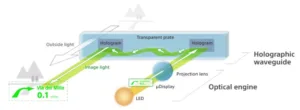The VisionAR augmented reality safety glasses, produced by Univet S.r.l. (Rezzato, Italy), were designed for industrial applications (and were recently shown at AWE (UniVet Developing AR Safety Glasses). The headset includes a monocular projection system based on Sony’s holographic optical engine. The glasses produces green imagery and allows the wearer to interact with menu items. The glasses also have a side panel that can be used for input with swiping gestures.
The Vision AR was developed as a joint venture between Univet and Sony. Sony provided the optical engine while all electronics were developed by Univet.
The Sony LMX-001 holographic optical engine is a thin, lightweight display module designed for glasses with a transparent lens. The module displays imagery in the user’s field of view. The module is made up of two parts: the optical engine, which projects imagery using microdisplay technology, and a holographic waveguide. The waveguide is a transparent plate of glass just 1 mm thick. The waveguide takes the light produced by the optical engine and projects a virtual image through the holographic optical elements to the eye of the wearer.
The configuration of the Sony holographic optical engine is illustrated in the figure below.
The configuration of the Sony holographic optical engine.
When the display is off, the VisionAR provides an unobstructed view through the safety glass. Together with the protective cover, the transmission of outside light to the wearer is in excess of 85%.
The VisionAR is demonstrated in a video that can be found at the end of this article. The configuration of the VisionAR is illustrated in the figure below.
The configuration of the VisionAR safety glasses.
There is a mechanical feature on top of the glasses frame that allows mounting accessory devices that may be needed in various applications. Such devices include a camera, a status LED, a temperature sensor, an IR sensor, a light sensor, a barometer sensor or a microphone for voice control.
Other features of the glasses include the following:
- An interchangeable front lens.
- Reinforcement to meet the quality requirements needed for professional and industrial uses.
- The ability to accommodate a wearers existing prescription glasses.
- The ability to adjust the position of the image in 3D space to fit the wearer’s pupillary distance and/or any special needs that may exist for various application.
Univet also offers a control box that can be connected to the glasses via a USB C. The control box is described as “an intelligent factory control unit in which management systems for the factory are already integrated.” -Arthur Berman
Univet, +39 030 2499411, [email protected]

